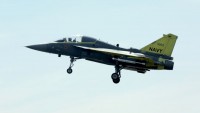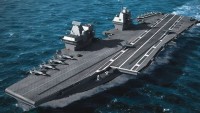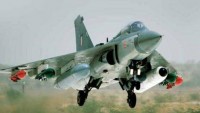Indian Navy Buying Three EMALS Catapults for Future Supercarriers, Including INS Vishal
| Arthur Dominic Villasanta | | Nov 14, 2016 05:04 PM EST |
(Photo : US Navy) EMALS test on the USS Gerald R. Ford involving the launch into the ocean of large sleds on wheels to simulate the weight of an aircraft.
The Indian Navy confirms plans to integrate the U.S.-made Electromagnetic Aircraft Launch System (EMALS) catapults into its future supercarriers by revealing the dispatch of Letters of Request (LoR) to the U.S. Department of Defense to buy this advanced aircraft launch system.
It said the LoRs cover the purchase of three EMALS under the U.S. Foreign Military Sales Program. Sources in the Indian Navy told media the LoRs were issued last February and are now under consideration by the Pentagon.
Like Us on Facebook
The navy expects the Pentagon to approve the LoRs and to issue its Letters of Acceptance (LoA) approving the deal within the next few months.
EMALS is being developed by U.S. defense contractor General Atomics for the U.S. Navy's newest class of nuclear supercarrier, the Gerald R. Ford. The lead ship of this class, the USS Gerald R. Ford (CVN-78), will be the first U.S. Navy carrier equipped with EMALS. The Ford is scheduled for deployment in 2019.
EMALS launches carrier-based aircraft from an aircraft catapult using a linear motor drive instead of the conventional steam piston drive.
Its main advantage is it allows for a more graded acceleration, inducing less stress on the aircraft's airframe. It's also lighter than a steam catapult system and cheaper to operate. In addition, EMALS can launch aircraft that are heavier or lighter than those handled by steam catapults.
"As far as General Atomics is concerned, we will be opening an office in the Indian capital to assist both the governments as required," said Vivek Lall, Chief Executive (Global Commercial Strategic Development) for General Atomics.
INS Vishal will deploy an EMALS catapult assisted take-off but arrested recovery (CATOBAR) aircraft launch system.
Her EMALS CATOBAR system will allow her to launch heavier aircraft like larger fighters; unmanned air combat vehicles (UCAVs); turbo-prop airborne early-warning aircraft and aerial refueling tankers. INS Vishal remains under development, however, and it is unclear when her construction will begin.
With a planned displacement of 65,000 metric tons, INS Vishal is the second ship of the Vikrant-class and the first supercarrier to be built in India.
TagsIndian Navy, Electromagnetic Aircraft Launch System, EMALS, INS Vishal, General Atomics, U.S. Foreign Military Sales Program, USS Gerald R. Ford
©2015 Chinatopix All rights reserved. Do not reproduce without permission
 New Tejas Fighter/Attack Jet will Equip INS Vishal Supercarrier and INS Vikrant Carrier
New Tejas Fighter/Attack Jet will Equip INS Vishal Supercarrier and INS Vikrant Carrier Nuclear Powered INS Vishal, India’s First Supercarrier, will Deploy EMALS
Nuclear Powered INS Vishal, India’s First Supercarrier, will Deploy EMALS India Acquires 83 ‘Tejas’ Fighter/Attack Jets with Stealth Features for the Indian Air Force
India Acquires 83 ‘Tejas’ Fighter/Attack Jets with Stealth Features for the Indian Air Force India Leases another Russian Nuclear Submarine; will also Lease a Third
India Leases another Russian Nuclear Submarine; will also Lease a Third US, India to Sign Pact Allowing Use of Each Other’s Military Bases
US, India to Sign Pact Allowing Use of Each Other’s Military Bases
EDITOR'S PICKS
-

Did the Trump administration just announce plans for a trade war with ‘hostile’ China and Russia?
-

US Senate passes Taiwan travel bill slammed by China
-

As Yan Sihong’s family grieves, here are other Chinese students who went missing abroad. Some have never been found
-

Beijing blasts Western critics who ‘smear China’ with the term sharp power
-

China Envoy Seeks to Defuse Tensions With U.S. as a Trade War Brews
-

Singapore's Deputy PM Provides Bitcoin Vote of Confidence Amid China's Blanket Bans
-

China warns investors over risks in overseas virtual currency trading
-

Chinese government most trustworthy: survey
-

Kashima Antlers On Course For Back-To-Back Titles
MOST POPULAR
LATEST NEWS
Zhou Yongkang: China's Former Security Chief Sentenced to Life in Prison

China's former Chief of the Ministry of Public Security, Zhou Yongkang, has been given a life sentence after he was found guilty of abusing his office, bribery and deliberately ... Full Article
TRENDING STORY

China Pork Prices Expected to Stabilize As The Supplies Recover

Elephone P9000 Smartphone is now on Sale on Amazon India

There's a Big Chance Cliffhangers Won't Still Be Resolved When Grey's Anatomy Season 13 Returns

Supreme Court Ruled on Samsung vs Apple Dispute for Patent Infringement

Microsoft Surface Pro 5 Rumors and Release Date: What is the Latest?









